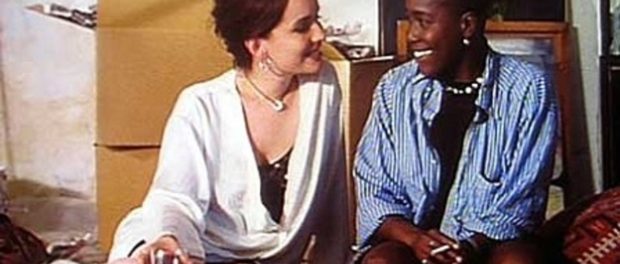Review: The Watermelon Woman
The 1996 lesbian film The Watermelon Woman has recently been re-released in a restored DVD format in order to commemorate its 20th anniversary. The groundbreaking film was written, directed, and starred Cheryl Dunye and dealt with issues related to race as well as homosexuality. Amidst our current political environment it’s clear (and very unfortunate) that the racially charged subject matter is just as relevant now as it was when the film initially opened 21 years ago.
https://www.youtube.com/watch?v=uXRYhmx9AXo
It’s more than obvious that The Watermelon Woman was strongly influenced by the success of another lesbian classic, that being 1994’s Go Fish. Filmmaker Cheryl Dunye seems to be overtly acknowledging the significance of this earlier film by casting one of that it’s co-stars, Guinevere Turner, as her character’s onscreen love interest. The Watermelon Woman also includes a comical cameo by another Go Fish co-star V.S. Brodie early on in the film’s narrative.
The Watermelon Woman attempts to deal with a number of cultural and social problems surrounding not only the feminist movement but also specifically the realities of what it means to be a black lesbian living within a milieu that’s constantly negating and/or marginalizing your very existence. The central premise of the film deals with Dunye, a young black lesbian filmmaker shooting a documentary about a black actress from the 30s known as the Watermelon Woman.
The problem with The Watermelon Woman, like so many other low budget independent films, lies with its disjointed plot and amateurish acting. Filmmaker Dunye also tries to tackle too many issues within the limited course of the narrative. She not only shines a light on timely modern day problems related to issues such as sexism, racism, and homophobia, but also tries to address age-old issues relating to the absence or negation of black talent within cinematic history. Later on in the movie, Dunye even includes a brief scene of being harassed by several police officers solely on the basis of her skin colour. Unfortunately this sequence disappears just as swiftly as it appeared and is never mentioned again.

The Watermelon Woman.
Another problem with The Watermelon Woman is the romance between Dunye and Turner which seems totally contrived and not believable in the slightest. Their “love story” simply serves as a way of inviting comparisons between the relationship between the two modern lesbians and the forbidden love shared by the Watermelon Woman and her white female director which was even more socially and culturally taboo at the time. Both of these couples prove that although times have changed, deep-seated attitudes concerning race, interracial relationships, intensity, and social status haven’t evolved nearly as much as they should have.
Although the actual character explored in the film, the so-called Watermelon Woman, is fictional she represents legions of under-appreciated and ignored black actress in American film history. Symbolically she represents all those talented actresses of colour who were passed over for starring roles due to the colour of their skin rather than the strength of their talent. In a similar way, the female director often noted in The Watermelon Woman is an obvious reference to well-known lesbian director Dorothy Arzner. One can only wonder how successful each of these artists would’ve become without the yokes of racism, sexism, and homophobia.
The Watermelon Woman is now out on DVD.






